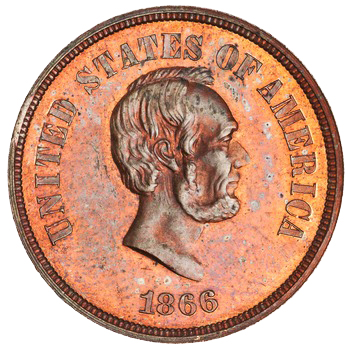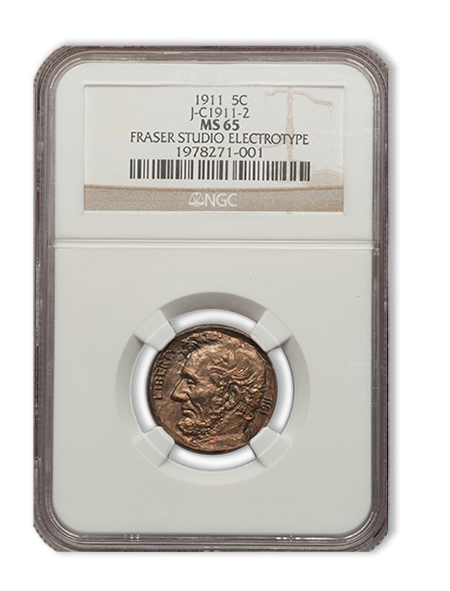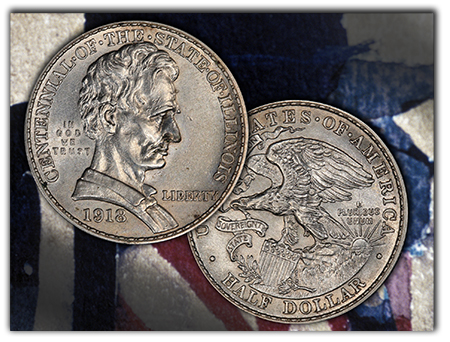Abraham Lincoln by Eric Brothers for CoinWeek …..
When one thinks of the image of Abraham Lincoln upon a coin, Victor David Brenner’s cent is the first thing that comes to mind. And, for the vast majority of people, it’s the only thing that comes to mind. At the time of its debut the Lincoln cent was revolutionary, replacing Lady Liberty–the symbol of our nation–with the face of a mortal man.

Brenner was interviewed by The Numismatist in 1909 when he was busy making several time-consuming changes to his then-new design. The image on the coin resembled his Lincoln plaque of 1906-07, but there are significant differences; Brenner was asked to compare his work on the plaque and the forthcoming coin.
“The other, yes, it is good, but this one is more intimate, deeper, more kind and personal. It is closer to the man; it makes you feel that you are sitting with him in his library. When it is finished I shall be nearly satisfied with it.”
Why did Brenner suggest to President Roosevelt placing the image of Lincoln on the one-cent piece?
“It seemed to me that the nickel had a very practical design, and so I turned my attention to what would be most fitting for the one-cent coin. Naturally, the portrait of Lincoln suggested itself, this being his centennial, and besides, I was going to make an anniversary medal for my friends and my mind was full of Lincoln.”
There are several coins that have the image of Abraham Lincoln upon them. Some are very rare, while others may be in your pocket change. They are detailed below for the reader.
Pattern Lincoln 5-Cent Piece (1866)
The martyred president was honored on a pattern coin in 1866, the year after his death. These five-cent pieces were struck in nickel, copper, bronze and brass, according to United States Pattern Coins (10th Ed., 2008) by J. Hewitt Judd. They are numbered J-486, J-487, J-488, and J-488a, respectively. An important numismatic item, it is the only official Lincoln pattern coin produced by the U.S. Mint in the 19th century.
 Chief Engraver James B. Longacre was given the task of creating designs for the proposed five-cent coinage. The coin’s obverse presents a right-facing Lincoln with ‘UNITED STATES OF AMERICA” surrounding him at the rim. The date ‘1866’ sits below him. The reverse has the Arabic numeral ‘5’ above the word ‘CENTS,’ encircled by a large laurel wreath. ‘IN GOD WE TRUST’ sits above the wreath near the rim.
Chief Engraver James B. Longacre was given the task of creating designs for the proposed five-cent coinage. The coin’s obverse presents a right-facing Lincoln with ‘UNITED STATES OF AMERICA” surrounding him at the rim. The date ‘1866’ sits below him. The reverse has the Arabic numeral ‘5’ above the word ‘CENTS,’ encircled by a large laurel wreath. ‘IN GOD WE TRUST’ sits above the wreath near the rim.
It was not adopted. The reason given is that Mint Director Robert Pollock was concerned about a negative reception of the coin in the southern states.
A handful of these Lincoln rarities have been sold at auction over the years. The most recent sale was by Heritage Auction Galleries in 2012. The Heritage listing tells us that “[t]he fields are bright and each side retains significant original mint red that is intermixed with streaky blue-brown patina.” Graded PR66RB by PCGS and approved by CAC, this piece (J-487) fetched US$21,850.
Another example hit the auction block in 2010 courtesy of Heritage. This one (J-488) was graded PR64RB by PCGS, and was part of the Bob Simpson Collection. Heritage says that “[s]trongly mirrored surfaces are pink-rose at the margins with cool blue-violet centers.” This specimen realized $12,650.
Fraser’s Lincoln Nickel Pattern (1911)
In 1911 James Earle Fraser heard that a new nickel design was being sought by U.S. Treasury Secretary Franklin MacVeagh. Fraser contacted and later met with Mint Director George E. Roberts and other mint officials. During the meeting, Roberts told the artist that a Lincoln head was planned for the new coin.
 On June 13, 1911, Fraser wrote to Roberts:
On June 13, 1911, Fraser wrote to Roberts:
“I think your idea of the Lincoln head is a splendid one and I shall be very glad to make you some sketches as soon as possible and let you see them. I think they should be reduced to the actual size of the coin; otherwise we will not be really able to judge them, even in the sketch period. I will have that done here, where I can watch the process.”
The idea eventually was dropped.
However, before the idea was completely pushed aside, Fraser created an electrotype of a nickel that featured a profile of Abraham Lincoln facing left, with ‘LIBERTY’ along the left side. The date ‘1911’ is along the right side. It is not a U.S. Mint product, but its numismatic significance is quite evident. Crafted by Fraser in his studio, it is a uniface pattern design made of white metal with a plain edge.
The Heritage auction listing tells us that it is “[p]robably unique” and has a “[r]ich, reddish-gold color.” This striking coin, Judd-C1911-2, was graded MS 65 by NGC, and sold at the ANA US Coins Signature Auction in Chicago, August 5-9, 2014, lot #5826, for $42,593.75. This coin has textured letters in LIBERTY. The second Fraser pattern, JC-1911-3, has smooth letters in LIBERTY.
Illinois Centennial Half Dollar (1918)
The year 1918 saw George T. Morgan’s version on Abraham Lincoln on the Illinois Centennial half dollar.
Actually, Morgan’s bust of Lincoln was copied from a statue sculpted by Andrew O’Connor Jr., which was officially unveiled at Springfield, Illinois, in August of 1918. The Lincoln found on the Illinois coin is the young lawyer, sans beard, on the eve of his career in politics.
 O’Connor had assisted the American Daniel Chester French in his studio and studied with John Singer Sargent in London and Auguste Rodin in Paris. The sculptor produced several of these Lincolns, one of which was cut in stone in 1916 from a model created in 1915.
O’Connor had assisted the American Daniel Chester French in his studio and studied with John Singer Sargent in London and Auguste Rodin in Paris. The sculptor produced several of these Lincolns, one of which was cut in stone in 1916 from a model created in 1915.
Morgan did not need to work on translating the statue into a bust to place upon the surface of a coin – O’Connor had already prepared some. Examples of these busts can be found at the Metropolitan Museum and the Whitney Museum in New York, the Royal Exchange in London, and the Art Institute in Chicago. One would imagine that Morgan took a train to New York to sketch one of the Lincoln busts there.
In his book Numismatic Art in America, Cornelius Vermeule writes that “Morgan’s interpretation has captured the restless plasticity of this bust, yet another indication of the benefits for coin design of good monumental models in sculpture.”
Fraser’s Lincoln Cent Pattern (1952)
In 1951, James Earle Fraser, the designer of the Buffalo nickel (among other numismatic works), sent unsolicited obverse and reverse designs for a new Lincoln cent to Mint Director Nellie Tayloe Ross. Viewing Fraser’s work, she gushingly replied to him: “…It is with a real thrill of admiration and appreciation I behold these beautiful productions of your art. The portrait of Lincoln impresses me as being incomparably better than the one now impressed upon the one-cent piece.”
The obverse of Fraser’s cent presented a large scale image of Abraham Lincoln , similar to his 1911 Lincoln nickel pattern (see above). The reverse features an oak tree, wrote Fraser, “…as a symbol because Lincoln was a woodsman…It stands too for strength, ever renewing growth, and unity. Like a nation, it has roots, a trunk, branches, flowers and finally fruit.”
Director Ross convinced the Secretary of the Treasury to allow pattern coins to be produced. On May 7, 1952, 46 of them were struck, and on June 19 another 100 were made from dies with slightly lower relief.
Even though Ross, the Secretary and other influential people supported using Fraser’s new design, it was not to be. There was a strong demand for coinage and the Mint could hardly keep up with normal production. The project was scrapped in March of 1953.
The existing 146 pattern cents were destroyed on March 16, 1953. All dies used to produce the pattern cents were secured in the engraver’s safe, and the coin models placed in storage at the Philadelphia Mint. In 1995 Bill Fivaz photographed the obverse. It is not known if the photo is of a galvano or a plastic model colored to resemble the final product.
Coins of Lincoln Coins in the 21st Century
The Illinois State Quarter (2003) presents Lincoln as a young man. It is adapted from the bronze statue of the 16th president (“The Resolute Lincoln”) by sculptor Avard Fairbanks, which displayed at New Salem, Illinois. Donna Weaver designed this rendering of Lincoln.
Lincoln is also found on the obverse of the South Dakota State Quarter (2006) upon the Mt. Rushmore national landmark, along with George Washington, Thomas Jefferson and Teddy Roosevelt. The designer was John Mercanti.
February 12, 2009, saw the US Mint release the Abraham Lincoln Commemorative Silver Dollar. The coin’s obverse features a close-up image of Lincoln–inspired by Daniel Chester French’s sculpture in the Lincoln Memorial–and was designed by Justin Kunz and engraved by US Mint Sculptor-Engraver Don Everhart. The reverse, which presents the closing words of the Gettysburg Address, a laurel wreath, and a banner carrying Lincoln’s signature, was designed and engraved by US Mint Sculptor-Engraver Phebe Hemphill.
There were four bicentennial Lincoln cents produced in 2009. Two of them carry the image of Lincoln. They are the Rail Splitter design, which shows a young Lincoln taking a break from his work as a rail-splitter. It was designed and engraved by Charles Vickers. The Politician design shows Lincoln standing in front of the Illinois State Capitol building. This image was designed by Joel Iskowitz and engraved by Don Everhart.
Minted in 2010, the Abraham Lincoln Presidential Dollar was designed and engraved by Don Everhart. It features the image of Lincoln on the obverse. The reverse of this coin is the same as the other presidential dollars. It presents an image of the Statue of Liberty (also designed and engraved by Everhart). The official launch ceremony for this coin took place at the Lincoln Cottage in Washington, DC. The President Lincoln and Soldiers’ Home National Monument is referred to as “President Lincoln’s Cottage” at the Armed Forces Retirement Home.
* * *
Sources
“A New Type Cent Soon to Be Issued — Will Bear Lincoln’s Head”, The Numismatist. March, 1909.
Judd, J. Hewitt. United States Pattern Coins, Ninth Edition. Whitman Publishing, LLC. 2005.
“Eric Newman’s 1866 Five Cent Lincoln Judd-487 Pattern,” The E-Sylum: Vol. 16, No. 15, April 14, 2013, Article 17. http://www.coinbooks.org/esylum_v16n15a17.html. Accessed August 16, 2016.
“1866 5C Five Cents, Judd-487, Pollock-576, Low R.7, PR66 Red and Brown PCGS. CAC.” 2012 April 18-22 US Coins & Platinum Night CSNS Signature Auction – Schaumburg #1169, lot #5409.
http://coins.ha.com/itm/patterns/1866-5c-five-cents-judd-487-pollock-576-low-r7-pr66-red-and-brown-pcgs-cac/a/1169-5409.s?ic4=ListView-ShortDescription-071515. Accessed August 16, 2016.
“1866 5C Five Cents, Judd-488, Pollock-576, High R.7, PR64 Red and Brown PCGS.” 2010 August Boston, MA Signature & Platinum Night ANA Coin Auction #1143, lot #5681.
http://coins.ha.com/itm/patterns/1866-5c-five-cents-judd-488-pollock-576-high-r7-pr64-red-and-brown-pcgs/a/1143-5681.s?ic4=ListView-ShortDescription-071515. Accessed August 16, 2016.
“1911 5C James Fraser Studio Electrotype, Judd-C1911-2, MS65”; NGC. 2014 August 5, 7 & 9 ANA US Coins Signature Auction – Chicago, lot #5826.
http://coins.ha.com/itm/patterns/1911-5c-james-fraser-studio-electrotype-judd-c1911-2-ms65-ngc/a/1208-5826.s?ic4=ListView-ShortDescription-071515. Accessed August 16, 2016.
Vermeule, Cornelius. Numismatic Art in America: Aesthetics of the United States Coinage. 2nd Edition. Whitman Publishing, LLC. 2007.
“1952 Lincoln Cent”, http://uspatterns.com/19lincen.html. Accessed August 16, 2016.





I liked this page